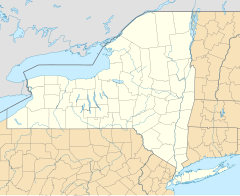Bayonne Bridge
| Bayonne Bridge | |
|---|---|

Late 2016, with both old deck and new
|
|
| Coordinates | 40°38′31″N 74°08′31″W / 40.642043°N 74.141965°WCoordinates: 40°38′31″N 74°08′31″W / 40.642043°N 74.141965°W |
| Carries | 4 lanes of |
| Crosses | Kill Van Kull |
| Locale | Staten Island, New York City and Bayonne, New Jersey |
| Maintained by | Port Authority of New York and New Jersey |
| Characteristics | |
| Design | Steel Arch bridge |
| Total length | 5,780 feet (1,762 m) |
| Width | 85 feet (26 m) |
| Longest span | 1,675 feet (510.54 m) |
| Clearance above | 14 feet |
| Clearance below | 151 feet (46.03 m) |
| History | |
| Opened | November 15, 1931 |
| Statistics | |
| Daily traffic | 19,420 (2010) |
| Toll | (southbound only) As of 6 December 2015[update]; Cars $15 for cash, $12.50 for Peak (E-ZPass), $10.50 for off-peak (E-ZPass) |
The Bayonne Bridge is an arch bridge spanning the Kill Van Kull connecting Bayonne, New Jersey with Staten Island, New York City. It carries NY 440 and NJ 440. The supported roadway carries two lanes of motor traffic in each direction, as well as a walkway that is temporarily closed for reconstruction. The roadway deck could accommodate an expansion for either two traffic lanes or two light-rail lanes.
The Bayonne Bridge is the fifth-longest steel arch bridge in the world, and was the longest in the world at the time of its completion. The bridge is also one of four connecting New Jersey with Staten Island; the other two roadway bridges are the Goethals Bridge in Elizabeth and Outerbridge Crossing in Perth Amboy, and the rail-only Arthur Kill Vertical Lift Bridge, all of which traverse the Arthur Kill.
There is an ongoing project to raise the roadbed, providing increased clearance for shipping to accommodate neo-Panamax ships. As of October 2016, the new roadway spans the length of the bridge, and a navigational clearance of 215 feet above mean high waters is expected to be achieved in late 2017, with project completion in mid-2019.
The bridge was designed by master bridge-builder Othmar Ammann and the architect Cass Gilbert. It was built by the Port of New York Authority (now the Port Authority of New York and New Jersey) and opened on November 15, 1931, after dedication ceremonies were held the previous day. The bridge became a National Historic Civil Engineering Landmark in 1985. Ammann, the master bridge builder and chief architect of the Port Authority, chose the steel arch design after rejecting a cantilever and suspension design as expensive and impractical for the site, given a requirement by the Port Authority that the bridge must be able to accommodate the future addition of rapid transit tracks.
...
Wikipedia




